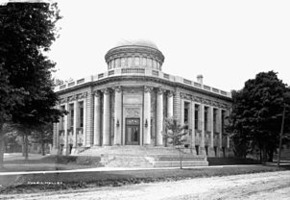Show Your Library Some Love
- James D. A. Terry

- Oct 18, 2022
- 2 min read

The concept of libraries is thousands of years old, going back to around 2600 BCE when all that they consisted of were tablets written in cuneiform.
A strong library system is the cornerstone of a strong community. It facilitates equity of access to information and contributes to education, literacy and life-long learning.
The earliest libraries in Canada were private collections belonging to immigrants from Europe. The first known library belonged to Marc Lescarbot, a scholar and advocate who came to Port-Royal, Nova Scotia in 1606.
By mid 19th century, libraries were firmly established in British North America. The first free tax-supported public libraries date from 1883 at Saint John, Guelph and Toronto.
However, the development of the public library as it is known today was a slow evolution through a variety of forms, in response to the geographic, economic, cultural and demographic conditions of each province. Predecessors of the modern, tax-supported public library were school-district libraries, mechanics' institutes and association or social libraries, supported by subscription fees.
In 1882 an Act of the Ontario legislature provided for the establishment of free libraries, supported financially by a levy to be assessed on the value of all real and personal property. A local board composed of 9 members appointed by the municipal council and school boards was to provide leadership. The Toronto Public Library was the largest among the first libraries to choose free status. This Ontario pattern of legislating tax support for library services usually was followed in other provinces
Ontario’s first free public libraries were established in Toronto and Guelph in 1883. Between 1903 and 1922, 111 Ontario libraries were constructed with more than $2.5 million in funding from American businessman and philanthropist Andrew Carnegie.
In the early 1890s, Scottish-American industrialist and self-made millionaire Andrew Carnegie wrote that among institutions that could most benefit from philanthropy, the "best gift" to a community was a free, or "public," library. Carnegie credited his success in life partly from his childhood and teenage access to library books
There are over 150 library associations in Canada, including national, provincial, regional, local, and ethnic associations, and groupings by library type such as public, academic, government, school and special libraries. The first was the Ontario Library Association, established in 1900.
Today, over 4.2 million Ontarians, or nearly 33% of the population, hold a public library card.
Ontario libraries have nearly 28.5 million print volumes available to borrow. That’s equivalent to 2.49 books for every Ontarian. They also have over 21.6 million e-resources including e-books. Every library branch in the province provides access to electronic information through the internet.
Take some time to visit your library this week and if you like mysteries try the latest sub-genre, Brozy Mysteries. In the spirit of Ontario Public Library Week why not check out a mystery set in Ontario, Chasing the Wendigo, first in the Justin and friends Brozy Mystery series?








Comentarios